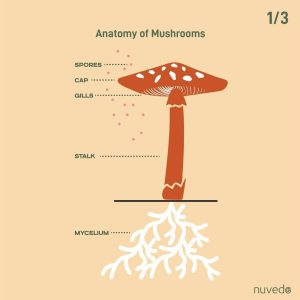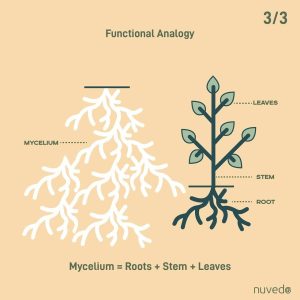Lifecycle of a Mushroom
Typically when one thinks of mushrooms, the white dome of a button mushroom appears in the mind’s eye. This is but one of the many thousands of varieties of mushrooms inhabiting our planet today. Mushrooms come in a plethora of shapes, sizes and colours and while some are delicious to devour, others are medicinal marvels or frivolously fatal. So, let us take a deeper look at what these organisms are and how they grow.
What are mushrooms?
Mushrooms, contrary to what we may think are but a small portion of a much larger organism that grows beneath the plane accessible to out visual field. The mushroom is equivalent to fruit and its job description is similar to that of a fruit. It is a fruiting body that arises from a network of thread-like mycelia that represents the main functional body of a group of fungi known as Basidiomycetes (with some exceptions). The mycelium feeds on plant matter and dead decomposing wood, at the same time releasing the nutrients locked within these substrates for other organisms such as bacteria to consume. Once the mycelium is ready to reproduce, it sends out the mushroom fruiting body whose sole purpose is to reach up and out into the atmosphere and disperse spores which are the seeds that will give rise to new fungi.
Spores
 Spores represent the inherent potential in all of us as we set out in the world. As a spore is cast from the mushroom, it can travel far and wide in search of a suitable environment to set forth on its voyage to blossom into a fully grown mushroom. Once a spore experiences the right environmental triggers (some rare spores only germinate after a forest fire) biochemical changes within its dormant walls lead to the activation of genes that set the wheels of activity in motion. The tough outer walls of the spore give way to finger-like hyphae that spread in all directions in search of nutrients. The hyphae secrete proteins that break down complex organic matter into fuel for the growing fungus.
Spores represent the inherent potential in all of us as we set out in the world. As a spore is cast from the mushroom, it can travel far and wide in search of a suitable environment to set forth on its voyage to blossom into a fully grown mushroom. Once a spore experiences the right environmental triggers (some rare spores only germinate after a forest fire) biochemical changes within its dormant walls lead to the activation of genes that set the wheels of activity in motion. The tough outer walls of the spore give way to finger-like hyphae that spread in all directions in search of nutrients. The hyphae secrete proteins that break down complex organic matter into fuel for the growing fungus.
Mycelium
 As the fungus continues to thrive, hyphae elongate and divide, and branch. The branching network of interconnected hyphae is known as the mycelium. The mycelium weaves its way through the substrate sucking up all the nutrition it can find. Nutrition, however, is not all that the mycelium seeks. In order for the mycelium to blossom into a beautiful mushroom, it needs to find a very important compatriot. A mate.
As the fungus continues to thrive, hyphae elongate and divide, and branch. The branching network of interconnected hyphae is known as the mycelium. The mycelium weaves its way through the substrate sucking up all the nutrition it can find. Nutrition, however, is not all that the mycelium seeks. In order for the mycelium to blossom into a beautiful mushroom, it needs to find a very important compatriot. A mate.
As above so below I imagine. It is as difficult for the fungus to find a mycelial mate as it is for humans to settle on a Tinder date. Mushrooms come in thousands of different mating types and two mycelia can only mate if they have complementary mating genes. If two mycelia win the genetic lottery and prove to be compatible they merge into a single mycelial network known as the dikaryon which can then proceed to form a fruiting body.
 Fruiting Bodies Upon encountering favorable environmental conditions, the dikaryotic mycelium begins to sprout a fruiting body a.k.a. mushroom. The fruiting body is the main reproductive organ of the fungus and its primary purpose is the generation and dispersal of spores. The fruiting body marks an important stage in the life-cycle of the fungus and different fungi fruit in response to different conditions.
Fruiting Bodies Upon encountering favorable environmental conditions, the dikaryotic mycelium begins to sprout a fruiting body a.k.a. mushroom. The fruiting body is the main reproductive organ of the fungus and its primary purpose is the generation and dispersal of spores. The fruiting body marks an important stage in the life-cycle of the fungus and different fungi fruit in response to different conditions.
“Nature alone is antique, and the oldest art a mushroom.”





